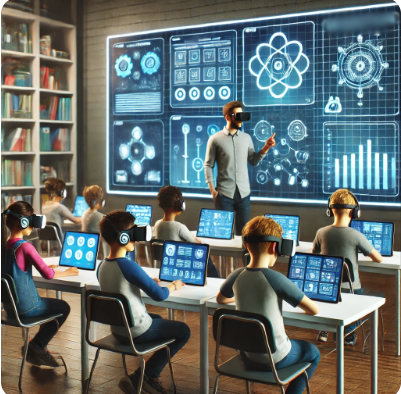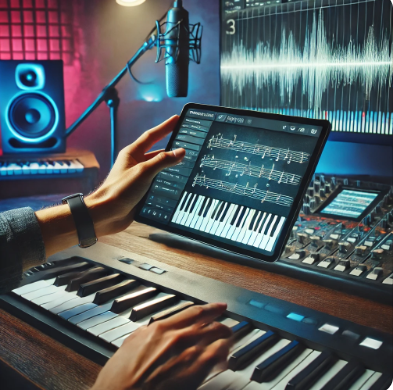"Tech-Powered Learning: How Gadgets Transform Education & Music"
edubeatsworld.com
Introduction
The advent of technology has fundamentally transformed the landscape of both education and music, ushering in an era that prioritizes interactivity, accessibility, and efficiency. Gone are the days when students relied solely on textbooks and classroom lectures; today’s learners are equipped with an arsenal of digital tools such as smartphones, laptops, e-books, and cutting-edge software that make knowledge acquisition an engaging and dynamic experience. Likewise, musicians have discovered an array of innovative platforms and applications that facilitate not only the creation of music but also its learning and sharing. In this blog, we will dive into the myriad ways technology enriches education and music, examining effective strategies for utilizing these resources. We will also discuss how to seamlessly integrate various digital tools to cultivate a more immersive and enriching learning experience, ultimately empowering both students and musicians to unlock their full potential. Join us on this exploration of the intersection between technology, education, and music, and discover how these advancements are paving the way for a brighter future of learning and creativity.


The Role of Technology in Education
1. Smartphones and Tablets: Learning on the Go
Smartphones and tablets have revolutionized the educational experience, providing unparalleled flexibility that enables students to learn anytime, anywhere. With an array of applications like Google Classroom, Duolingo, and Coursera, students can engage in online courses, submit assignments, and foster interactive relationships with their educators from the comfort of their own homes or on the move.
Example: A student grappling with complex math concepts can turn to applications like Photomath or Khan Academy, which offer step-by-step solutions and instructional videos, transforming confusion into clarity.
Quote: “Technology will not replace great teachers, but technology in the hands of great teachers can be transformational.” – George Couros
2. Laptops and E-Books: A Digital Library at Your Fingertips
Laptops and e-books have revolutionized the traditional education model by eliminating the burdensome weight of physical textbooks. E-books not only reduce costs but also offer interactive features such as highlighting, note-taking, and instant access to dictionaries and additional resources.
Statistics: According to a study by the Pew Research Center, over 80% of college students prefer e-books over traditional textbooks, attributing this shift to their convenience and affordability.
Example: Medical students, for instance, often rely on digital platforms like AccessMedicine for quick and efficient access to essential medical texts, allowing them to update their knowledge without incurring substantial costs.
3. Virtual Reality (VR) and Augmented Reality (AR): The Future of Interactive Learning
Virtual reality (VR) and Augmented reality (AR) technologies are pushing the boundaries of traditional learning, enabling students to immerse themselves in complex subjects and concepts like never before. These innovative tools facilitate experiential learning, making abstract theories tangible.
Example: Medical students can participate in advanced VR simulations where they practice surgeries in a risk-free environment, honing their skills before entering the operating room.
Quote: “VR and AR in education can create immersive experiences that were once unimaginable.” – Bill Gates
4. Artificial Intelligence (AI) in Education: Personalized Learning
The rise of Artificial Intelligence in Education has paved the way for personalized learning experiences tailored to individual student needs. AI-driven tools, such as chatbots and adaptive learning software, analyze student performance data and provide tailored lessons that fit varying learning styles and paces.
Example: Grammarly is a prime example of AI in education; It assists students in refining their writing skills by identifying grammar mistakes and offering contextual suggestions for improvement, allowing for a more effective learning process.
5. Online Collaboration Tools: Connecting Learners Globally
In an increasingly interconnected world, online collaboration tools such as Zoom, Google Meet, and Microsoft Teams have emerged as vital platforms for remote learning and global interaction. These technologies facilitate real-time discussions, group projects, and an overall more engaging learning experience.
Statistics: A study found that online learning can increase retention rates by 25-60% compared to traditional classroom settings, highlighting the effectiveness and promise of Technology-enhanced Education.
Through these advancements, Technology is not merely a supplement to Education; it is an essential component that fosters creativity, collaboration, and personalized learning, ultimately preparing students for the challenges and opportunities of the future.


The Role of Technology in Music Education
1. Digital Audio Workstations (DAWs) and Music Production Software
Digital Audio Workstations (DAWs) and music production software have revolutionized the way music students and professionals create, edit, and mix their compositions. Programs like FL Studio, Ableton Live, and GarageBand provide powerful tools that allow users to experiment with sound and produce high-quality music from the comfort of their own homes.
Example: Billie Eilish recorded her Grammy-winning album, "When We All Fall Asleep, Where Do We Go?", using Logic Pro X, showcasing how accessible and effective music production software can be for aspiring artists.
2. Online Music Lessons and Tutorials
With the rise of online platforms such as YouTube, Udemy, and MasterClass, aspiring musicians can now access lessons from world-class musicians and educators at their fingertips. This democratization of music education allows learners to study at their own pace and explore a diverse range of musical styles and techniques.
Quote: “Technology has democratized music learning. Anyone with an internet connection can become a musician.” – Hans Zimmer
3. Smart Instruments and AI-Powered Music Tools
The integration of technology into musical instruments has led to the development of smart instruments and AI-powered tools that enhance the learning experience. Smart keyboards, AI-driven guitar tuners, and digital sheet music apps help musicians of all levels improve their skills more efficiently.
Example: Yousician, an innovative AI-based app, listens to how users play their instruments and provides real-time feedback, making practice sessions more interactive and productive.
4. Virtual Reality for Music Learning and Performance
Virtual reality (VR) technology is opening new avenues for music education by allowing students to perform in immersive virtual concert halls. This not only helps them overcome stage fright but also enhances their stage presence and performance skills in a safe and supportive environment.
5. Cloud Storage and Collaboration in Music
Cloud-based tools like Google Drive and Soundtrap are increasingly popular among musicians, enabling real-time collaboration regardless of geographical barriers. These platforms facilitate seamless sharing of ideas, files, and projects, fostering a collaborative spirit in music creation.
Statistics: Over 60% of musicians now utilize cloud-based tools for music collaboration, highlighting the growing trend of remote teamwork in the music industry.
How to Use These Technologies Effectively
For Educators:
- Integrate multimedia content into lessons to enhance engagement.
- Encourage students to utilize e-books and learning apps to reinforce their understanding.
- Utilize AI-powered grading tools to provide instant feedback and support personalized learning.
For Students:
- Leverage study apps to reinforce learning and practice skills outside of formal lessons.
- Join online learning communities to connect with fellow musicians and share resources.
- Take advantage of digital note-taking apps like OneNote or Evernote to organize ideas and practice notes efficiently.
For Musicians:
- Experiment with various DAWs to discover your unique sound and production style.
- Enrol in online courses to learn new instruments or techniques, expanding your musical repertoire.
- Use cloud storage solutions to collaborate with musicians from around the world, fostering creativity and innovation.
Conclusion
Technology has undeniably transformed both Education and Music, providing students and educators with powerful tools to enhance learning and creativity. From AI-powered educational software to smart music gadgets, the possibilities for innovation are endless. By embracing these advancements, we can create a more engaging, personalized, and effective learning experience for all.
Call to Action
What are your favorite educational or music-related gadgets? Share your thoughts in the comments below! Your insights could inspire others to explore new tools and technologies in their own learning journeys.
RELATED POSTS
contact@edubeatsworld.com
© 2024. All rights reserved.
